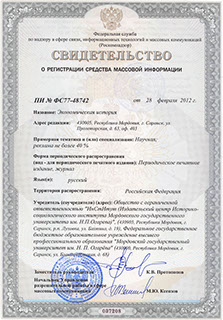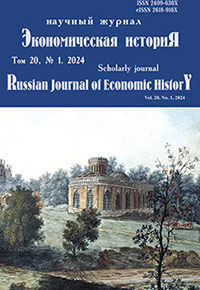Экономическая историЯ
Russian Journal of Economic History
ISSN 2409-630X (Print)
ISSN 2618-916X (Online)
Expert board:
- Scientific Council of RAS on economic history;
- Research and Educational Center «The economic history of Central Russia and the Middle Volga region» of Ogarev Mordovia State University;
- Center of Economic History of Lomonosov Moscow State University
Navigation
Certificate of registration

ISSN 2409-630X (Print), ISSN 2618-916X (Online)
DOI: 10.15507/2409-630X.064.020.202401.009-019
Olga V. Koshina
National Research Ogarev Mordovia State University (Saransk, Russia),
e-mail: koshinaolga@rambler.ru
The Standard of Living of Primary School Teachers in Russia in the Second Half of the 19th – Early 20th Centuries (On the Materials of the Middle Volga Region)
Abstract
Introduction. 2023 was declared by the President of Russia as the Year of the Teacher and Mentor. The key role of the teacher’s personality in education remains not only in the field of transferring knowledge and competencies, but also in educating young people. The standard of living of teachers, along with other factors, influences the quality of education, the prestige of the profession, and the effectiveness of social interaction at school. Therefore, it is important to study all aspects of the standard of living of primary school teachers.
Materials and Methods. The sociocultural approach made it possible to consider the standard of living of primary school teachers in the Middle Volga region in a broad socio-economic and historical-cultural context, taking into account social, economic, demographic, and cultural factors in the development of primary education in the second half of the 19th – early 20th centuries.
Results. The standard of living of primary school teachers in the Middle Volga region in the second half of the 19th century accompanied by low wages, absence or poor quality of housing, and difficult working conditions. The relative increase in the standard of living of primary school teachers at the beginning of the 20th century, compared with the first post-reform decades (increased salaries, the emergence of pensions, awards, some privileges) stimulated representatives of the lower classes (peasants and bourgeois) to devote their lives to teaching work. But the shortage of teachers remained a problem in the primary education system until the 1917 revolution. The increase in the number of teachers did not keep pace with the increase in the number of primary schools. The standard of living of primary school teachers remained low, and the outflow of experienced teaching staff from schools continued.
Discussion and Conclusion. The standard of living of a teacher depended on the place of service, the departmental affiliation of the school, the subject taught, and work experience. At the beginning of the 20th century, the standard of living of primary school teachers increased: they received the status of civil servants, a modest pension, the right to awards and some benefits (exemption from military service in peacetime, from the poll tax, jury duty), small compensation for rented housing and right to awards. The standard of living of teachers gradually rose thanks to the efforts of the Ministry of Public Education, zemstvos, city governments and teachers’ mutual aid societies.
Keywords: elementary school, teacher, standard of living, Middle Volga region, salary, pension, awards.
For citation: Koshina O. V. The Standard of Living of Primary School Teachers in Russia in the Second Half of the 19th – Early 20th Centuries (On the Materials of the Middle Volga Region). Ekonomicheskaya istoriya = Russian Journal of Economic History. 2024; 20(1): 9–19. (In Russ.). DOI: 10.15507/2409-630X.064.020.202401.009-019.
© Ogarev Mordovia State University. History and Sociology Institute, 2017
68, Of. 411, Bolshevistskaya St., 430005, The editorial office of the scholarly journal «Russian Journal of Economic History»
Tel.: (8342) 24-25-90; 27-07-11, Fax: (8342) 24-25-90, E-mail: jurnal-econom-hist@isi.mrsu.ru
Designed by A. Napalkov, Email: napalkov@isi.mrsu.ru

